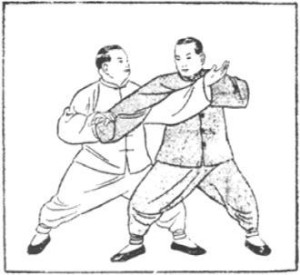Tui Shou (推手), or push-hands, can be used to train many things in the study of Taijiquan (太極拳), and different schools likely have numerous specialized methods for using this training tool. But, since I have seen online forums where practitioners question the fighting usefulness of push-hands (at least as commonly trained, especially as seen in competitions), I though that I would present my understanding of this training method.
Wikipedia does a good job of explaining Taijiquan push-hands (see: https://en.wikipedia.org/wiki/Pushing_hands). The article states that push-hands is the “gateway” to understanding the martial aspects of this art, but does not explain how practitioners would transition from the “gateway” of push-hands into fighting
It makes sense that such qualities as “leverage, reflex, sensitivity, timing, coordination and positioning” would be valuable for a fighter, and that training to “undo a person’s natural instinct to resist force with force, teaching the body to yield to force and redirect it” may differentiate Taijiquan training from many other styles of martial arts
I n addition to the principles mentioned in the Wikipedia article, I would propose that a major aspect of Taijiquan push-hands is training in the middle range. To transition into fighting with Taijiquan, practitioners may need to practice additional methods not commonly taught in the push-hands format
n addition to the principles mentioned in the Wikipedia article, I would propose that a major aspect of Taijiquan push-hands is training in the middle range. To transition into fighting with Taijiquan, practitioners may need to practice additional methods not commonly taught in the push-hands format
If we look at martial arts fighting in general, the typical distances utilized tend to fall into the two categories of striking (long) range and grappling (short) range.
In both MMA and Chinese Lei Tai competition fighting, it is fairly common to see competitors using primarily striking and grappling/throwing (transitioning to ground fighting in MMA), and there are many styles of fighting around the world that emphasize one or the other of these skills. In Western fighting styles, these would perhaps be best illustrated by boxing and wrestling.
But Taijiquan focuses on a middle range not typically emphasized in other systems, and rarely seen in MMA or Lei Tai fights. While striking and grappling are important aspects of fighting, and should not be ignored by Taijiquan practitioners, the emphasis is initially focused on developing skills in the middle range.
To land a strike, an opponent would need to cross through this middle range. Similarly, grappling would need to get inside this middle range to be effectively employed. From this middle range, with proper body dynamics, both effective strikes and throws can be achieved by skilled Taijiquan practitioners.
The middle range is a difficult range to control (thus its relative rarity), and this is what push-hands seeks to train. To succeed in this middle range, Taijiquan emphasizes sensitivity (“listening” and “understanding” energies) as well as stick and adhere, connect and follow (zhan nian lian sui 粘黏連隨) and other concepts.
For more information on zhan nian lian sui see: http://www.ycgf.org/Articles/Z-N-L-S/arti_znls.htm
Fighters whose strength is in striking typically defend by moving out of range, blocking, covering, slipping the attack, etc. But these strategies generally do not gain physical control of the opponent when contact is made. The opponent is free to attack again.
Conversely, grappling arts attempt to get close enough that striking becomes less effective, and to remain close where throws, take downs, locks, chokes, etc. are possible. This strategy focuses on physical control of the opponent, often ending in groundwork, and generally inhibits the ability of the opponent to attack freely.

Leave a Reply